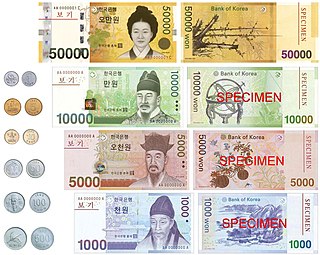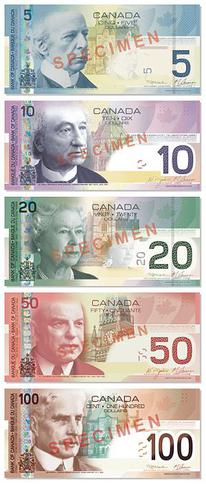The Kwacha is the currency of Zambia. It is subdivided into 100 Ngwee.

The Australian dollar is the official currency and legal tender of Australia, including all of its external territories, and three independent sovereign Pacific Island states: Kiribati, Nauru, and Tuvalu. As of 2022, it is the sixth most-traded currency in the foreign exchange market and also the seventh most-held reserve currency in global reserves.

The Canadian dollar is the currency of Canada. It is abbreviated with the dollar sign $. There is no standard disambiguating form, but the abbreviations Can$, CA$ and C$ are frequently used for distinction from other dollar-denominated currencies. It is divided into 100 cents (¢).
Federal Reserve Notes, also United States banknotes, are the currently issued banknotes of the United States dollar. The United States Bureau of Engraving and Printing produces the notes under the authority of the Federal Reserve Act of 1913 and issues them to the Federal Reserve Banks at the discretion of the Board of Governors of the Federal Reserve System. The Reserve Banks then circulate the notes to their member banks, at which point they become liabilities of the Reserve Banks and obligations of the United States.

The Philippine peso, also referred to by its Filipino name piso, is the official currency of the Philippines. It is subdivided into 100 sentimo, also called centavos.
The dollar has been the currency of The Bahamas since 1966. It is normally abbreviated with the dollar sign $, or alternatively B$ to distinguish it from other dollar-denominated currencies. It is divided into 100 cents.

The South Korean won is the official currency of South Korea. A single won is divided into 100 jeon, the monetary subunit. The jeon is no longer used for everyday transactions, and it appears only in foreign exchange rates. The currency is issued by the Bank of Korea, based in the capital city of Seoul.

The Malaysian ringgit is the currency of Malaysia. It is divided into 100 sen. The ringgit is issued by the Central Bank of Malaysia.

The Singapore dollar is the official currency of the Republic of Singapore. It is divided into 100 cents. It is normally abbreviated with the dollar sign $, or S$ to distinguish it from other dollar-denominated currencies. The Monetary Authority of Singapore (MAS) issues the banknotes and coins of the Singapore dollar.
Where's Willy? is a website that tracks Canadian paper money, most commonly $5 bills, but also higher denominations. "Where's Willy" is free, supported by users who pay a fee for extra features. The name Willy refers to Sir Wilfrid Laurier - the seventh Prime Minister of Canada whose portrait appears on the $5 banknote.
The Canadian twenty-dollar note is one of the most common banknotes of the Canadian dollar; it is the primary banknote dispensed from Canadian automated teller machines (ATMs). The newest version, the Frontier Series polymer note, was released to the general public on November 7, 2012, replacing the banknote from the Canadian Journey Series.

The Hockey Sweater is a short story by Canadian author Roch Carrier and translated to English by Sheila Fischman. It was originally published in 1979 under the title "Une abominable feuille d'érable sur la glace". It was adapted into an animated short called The Sweater by the National Film Board of Canada (NFB) in 1980 and illustrated by Sheldon Cohen.

Banknotes of the Canadian dollar are the banknotes or bills of Canada, denominated in Canadian dollars. Currently, they are issued in $5, $10, $20, $50, and $100 denominations. All current notes are issued by the Bank of Canada, which released its first series of notes in 1935. The Bank of Canada has contracted the Canadian Bank Note Company to produce the Canadian notes since then. The current series of polymer banknotes were introduced into circulation between November 2011 and November 2013. Banknotes issued in Canada can be viewed at the Bank of Canada Museum in Ottawa.
Scenes of Canada is the fourth series of banknotes of the Canadian dollar issued by the Bank of Canada. It was first circulated in 1970 to succeed the 1954 Canadian Landscape series and was followed by the 1986 Birds of Canada banknote series. This was the last series to feature a $1 bill, which was replaced by a $1 coin known as the loonie in 1987, although both the $1 bill and the loonie were produced concurrently for 21 months, from June 1987 to April 1989.

Canadian Journey is the sixth series of banknotes of the Canadian dollar designed and circulated by the Bank of Canada. It succeeded the 1986 Birds of Canada banknote series. The first banknote of the Canadian Journey series issued into circulation was the $10 bill on 17 January 2001, and the last to be issued was the $50 bill on 17 November 2004. The series was succeeded by the 2011 Frontier Series, the banknotes of which were first issued into circulation from 2011 to 2013.

Birds of Canada is the fifth series of banknotes of the Canadian dollar issued by the Bank of Canada and was first circulated in 1986 to replace the 1969 Scenes of Canada series. Each note features a bird indigenous to Canada in its design. The banknotes weigh 1 gram with dimensions of 152.40 by 69.85 millimetres. It was succeeded by the 2001 Canadian Journey series.

The New Zealand five-dollar note is a New Zealand banknote. It is issued by the Reserve Bank of New Zealand and since 1999 has been a polymer banknote. It was first issued on 10 July 1967 when New Zealand decimalised its currency, changing from the New Zealand pound to the New Zealand dollar. The note originally had an image of Queen Elizabeth II on the front; since 1992 it has had an image of Sir Edmund Hillary. The new design released in October 2015 was named "Banknote of the Year" by the International Bank Note Society for 2015.

The Frontier series is the seventh series of banknotes of the Canadian dollar released by the Bank of Canada, first circulated in 2011. The polymer banknotes were designed for increased durability and to incorporate more security features over the preceding 2001 Canadian Journey series. The notes feature images that focus on historic Canadian achievements and innovation. Printed on polymer, the 2011 Frontier series was the first series issued by the Bank of Canada printed on a material other than paper. The 2011 Frontier series was followed by the 2018 series.
The National Hockey League (NHL)'s Toronto Maple Leafs has been the point of subject for a number of media in Canadian popular culture, including artworks, books, novels, and songs.
The eighth series of banknotes of the Canadian dollar was first released by the Bank of Canada in 2018. Like the preceding 2011 Frontier series, the 2018 series consists of polymer banknotes designed for increased durability and to incorporate more security features. It is the first series issued by the Bank of Canada printed in a vertical configuration.












